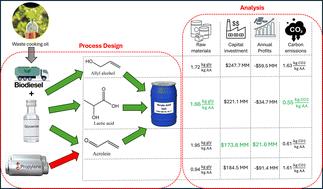生物基丙烯酸生产途径的技术经济评价
IF 9.2
1区 化学
Q1 CHEMISTRY, MULTIDISCIPLINARY
引用次数: 0
摘要
这项工作评估了生物基和传统路线生产丙烯酸的技术经济性能,丙烯酸是一种关键的工业化学品。以每年79.2万吨的生产能力评估了四种途径:三种基于甘油的途径(通过烯丙醇、乳酸和丙烯醛)和传统的基于丙烯的途径。比较了与丙烯酸产量、能耗、二氧化碳排放、原材料使用、资本支出、运营成本、盈利能力和投资回收期相关的关键绩效指标。在以甘油为基础的途径中,乳酸中间途径的碳转化效率最高(80%),其次是醇中间途径(74%)。从环境角度来看,丙基和甘油基烯丙醇中间路线的直接二氧化碳排放量最高,而甘油基丙烯醛中间路线的二氧化碳排放量最低。在成本方面,甘油基烯丙醇路线的资本投资最高(2.477亿美元),而丙烯醛路线所需的资本投资最低(1.736亿美元)。此外,以甘油为基础的丙烯醛中间体路线是唯一有利可图的途径(每年2160万美元),但在商业上没有吸引力,投资回收期为11.6年。敏感性分析显示,丙烯基路线最容易受到原材料价格变化的影响,而丙烯醛中间体路线对原材料和公用事业价格波动的抵御能力最强,在原材料价格上涨25%之前保持盈利能力。研究结果表明,可再生甘油基丙烯醛中间体路线可以成为传统丙烯酸生产的有前途的替代品,支持向更可持续的生物基化学工业过渡。本文章由计算机程序翻译,如有差异,请以英文原文为准。

Techno-economic assessment of bio-based routes for acrylic acid production†
This work evaluates the techno-economic performance of biobased and conventional routes for producing acrylic acid, a key industrial chemical. Four pathways were assessed at 79.2 ktonnes per year production capacity: three glycerol-based routes (via allyl alcohol, lactic acid, and acrolein) and the conventional propylene-based route. Key performance indicators related to acrylic acid yield, energy consumption, CO2 emissions, and raw material usage, as well as capital expenditure, OPEX, profitability, and payback period were compared. Among the glycerol-based routes, the lactic acid intermediate route had the highest carbon conversion efficiency (80%), followed by the alcohol intermediate route (74%). From an environmental perspective, propylene-based and glycerol-based allyl alcohol intermediate routes had the highest direct CO2 emissions, whereas the glycerol-based acrolein intermediate route had the lowest CO2 emissions. Regarding costs, the glycerol-based allyl alcohol route had the highest capital investment ($247.7 million), while the acrolein route required the lowest ($173.6 million). Moreover, the glycerol-based acrolein intermediate route was the only profitable pathway ($21.6 million annually) but with a commercially unattractive payback period of 11.6 years. Sensitivity analyses revealed that the propylene-based route was the most vulnerable to changes in raw material prices, whereas the acrolein intermediate route was the most resilient to price fluctuations in raw material and utilities, maintaining profitability until a 25% increase in raw material prices. The findings suggest that the renewable glycerol-based acrolein intermediate route can be a promising alternative to conventional acrylic acid production, supporting a transition towards a more sustainable bio-based chemical industry.
求助全文
通过发布文献求助,成功后即可免费获取论文全文。
去求助
来源期刊

Green Chemistry
化学-化学综合
CiteScore
16.10
自引率
7.10%
发文量
677
审稿时长
1.4 months
期刊介绍:
Green Chemistry is a journal that provides a unique forum for the publication of innovative research on the development of alternative green and sustainable technologies. The scope of Green Chemistry is based on the definition proposed by Anastas and Warner (Green Chemistry: Theory and Practice, P T Anastas and J C Warner, Oxford University Press, Oxford, 1998), which defines green chemistry as the utilisation of a set of principles that reduces or eliminates the use or generation of hazardous substances in the design, manufacture and application of chemical products. Green Chemistry aims to reduce the environmental impact of the chemical enterprise by developing a technology base that is inherently non-toxic to living things and the environment. The journal welcomes submissions on all aspects of research relating to this endeavor and publishes original and significant cutting-edge research that is likely to be of wide general appeal. For a work to be published, it must present a significant advance in green chemistry, including a comparison with existing methods and a demonstration of advantages over those methods.
 求助内容:
求助内容: 应助结果提醒方式:
应助结果提醒方式:


